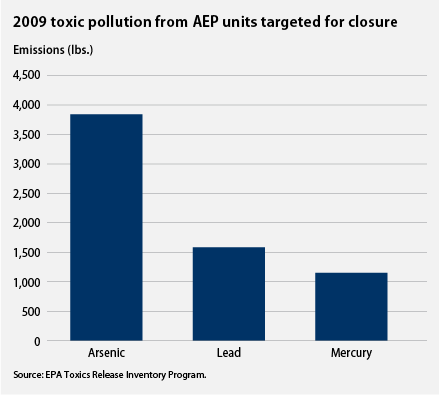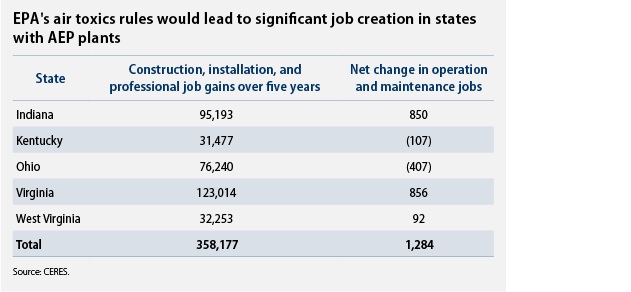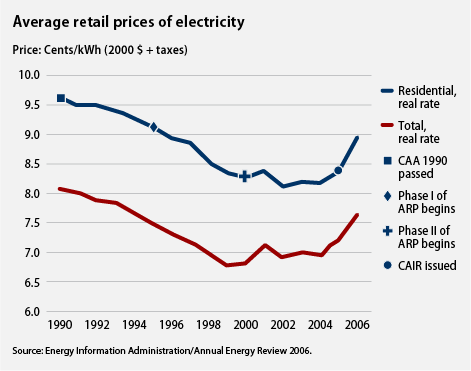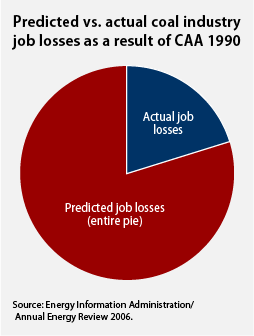 The Kammer Power Plant, which spewed 364 pounds of mercury in 2009, is one of the AEP’s plants slated to be closed. Photo: OZinOHCross-posted from the Center for American Progress. This post was coauthored by Valeri Vasquez, special assistant for energy policy at the Center for American Progress.
The Kammer Power Plant, which spewed 364 pounds of mercury in 2009, is one of the AEP’s plants slated to be closed. Photo: OZinOHCross-posted from the Center for American Progress. This post was coauthored by Valeri Vasquez, special assistant for energy policy at the Center for American Progress.
On June 9, American Electric Power (AEP), a major utility company that owns plants from Texas to Virginia, announced that it plans to close 21 coal-fired electricity units rather than invest in reducing their toxic air pollution to comply with the forthcoming Environmental Protection Agency reduction requirements [PDF]. In reality, AEP is threatening to shut down these plants to stoke congressional and public opposition to EPA’s efforts to reduce toxic air pollution. So far, several legislators have risen to the bait, including Sen. Joe Manchin (D-W.Va.) and Rep. Shelly Moore Capito (R-W.Va.). Both have again attacked EPA for attempting to protect children and others from cancer-causing air pollution. Other utilities, however, support EPA’s requirements, which are also job creators.
AEP would prefer to shutter these plants because it claims that the cost of reducing the arsenic, lead, mercury, acid gases, and other toxic pollutants is prohibitive. What AEP did not say is that the cost of cleanup is expensive because these units are very old and dirtier than newer plants — 50 years old on average (see attached spreadsheet). One of the units was built during World War II, and the newest one was completed during the Carter administration. Most of the other units were built in the 1950s.
AEP’s threat to close these plants due to the pending EPA air toxics rules is also somewhat misleading. Last year, it announced a plan to close five units at the Philip Sporn Plant in New Haven, W.Va. Source Watch, a nonprofit that publishes “documented information about the corporations, industries, and people trying to sway public opinion,” reported on AEP’s 2010 retirement plans:
In October 2010, Ohio Power Co. filed an application with the Public Utilities Commission of Ohio for the approval of a December 2010 closure of the coal-fired Philip Sporn Power Plant unit 5 … In September 2009, Appalachian Power filed an integrated resource plan (IRP) in Virginia that projected a 2010 shutdown for Sporn unit 5. The same IRP projected that Sporn units 1-4, with 580 megawatts of total capacity, would be retired in 2018.
In other words, AEP planned to close this plant five months before EPA’s March 2011 proposal to reduce toxic air pollution from coal-fired utilities. Yet AEP has included closing these units under “AEP’s current plan for compliance with the [EPA] rules as proposed includes permanently retiring the following coal-fueled power plants.”
The plants on the AEP chopping block are large emitters of toxic air pollution, particularly mercury (see attached spreadsheet for links to all TRI power plant data). This heavy metal causes severe developmental disabilities, deafness, and blindness in cases of prenatal and infant exposure. Mercury can also lower fertility rates and raise chances of heart disease in adults.
AEP’s aging power plants flood the sky with a deadly list of other toxic substances as well. The Big Sandy Plant contributed more than 1,300 pounds of cancer-causing arsenic to the air over Louisa, Ky., in 2009.
But these are just the tip of the toxic iceberg. In 2009, the 21 AEP units marked for closing pumped nearly 1,200 pounds of mercury into the air (see attached spreadsheet for links to Toxic Relief Inventory data on these pollutants from individual plants). They also emitted 3,842 of arsenic, which is used for rat poison. And these plants emitted nearly 1,600 pounds of lead, which causes learning disabilities in children as well as organ failure. Most shockingly, these 21 plants spewed 4.7 million pounds of acid gases. The American Lung Association [PDF] reports that these gases trigger “irritation to skin, eye, nose throat, [and] breathing passages.”
 AEP acknowledges that EPA’s standards would add employment. It noted that “jobs would be created from the installation of emissions reduction equipment.” In fact, the Wall Street Journal reports that: “AEP, whose utility operations stretch from Texas to Ohio, said high demands for labor and materials could drive the potential capital investment higher owing to a constrained time allowed to make changes required under the plan.” In other words, the reduction to toxic air pollution will drive more capital investment in other aging power plants, which will create jobs.
AEP acknowledges that EPA’s standards would add employment. It noted that “jobs would be created from the installation of emissions reduction equipment.” In fact, the Wall Street Journal reports that: “AEP, whose utility operations stretch from Texas to Ohio, said high demands for labor and materials could drive the potential capital investment higher owing to a constrained time allowed to make changes required under the plan.” In other words, the reduction to toxic air pollution will drive more capital investment in other aging power plants, which will create jobs.
This prediction is supported by a University of Massachusetts analysis for CERES [PDF] of the net job impact of the EPA’s air transport and utility air toxics rules. It found that there would be significant job creation — nearly 360,000 — due to “construction, installation, & professional job gains over 5 years” from capital expenditures to reduce these pollutants. In addition, many of the AEP-affected states with closing plants would still experience a net increase in operation and maintenance jobs:

Closing aging, dirty power plants will certainly end employment for some workers. Those affected by this should receive assistance with job placement, retraining, and education. But that is no excuse for blocking or delaying reductions in cancer-causing chemicals from coal-fired power plants.
What’s more, many utilities believe that EPA’s proposed reduction in air toxics can be met without significant rate increases or a decline in electricity reliability. In fact, many coal-fired power plants are already meeting the proposed mercury reduction standard. The Clean Energy Group [PDF] — an electric company coalition that has 146,000 megawatts of the United States’ total electric generating capacity — conducted an analysis that found that:
Nearly 60 percent of all coal fired boilers that submitted stack test data to EPA are currently achieving the Utility Toxics Rule’s proposed mercury emissions standard … Many states already impose more stringent mercury emissions limits on coal fired power plants than have been proposed by EPA.
The Clean Energy Group also evaluated PJM Interconnection’s — a regional transmission organization — recent “future capacity auction” that ensures:
… future electric system reliability [with] PJM’s forward capacity auction [that] requires power plant operators and other participating companies to offer (i.e., commit) resources, including both generating capacity and demand side resources, three years in advance of when they are needed.
This auction was an early test of whether there would continue to be adequate electricity generation to meet demand. The success of the auction proves that utilities do not anticipate any shortage of electricity in the PJM region and thus have capacity to meet the forthcoming EPA requirements:
The results of PJM’s most recent Reliability Pricing Model (“RPM”) forward capacity auction clearly indicate the industry can meet future electricity demand while maintaining electric system reliability in one of the most coal dependent regions of the country [the Mid-atlantic and Midwestern states].
Tennessee Valley Authority owns and operates 11 coal-fired power plants with nearly 60 electricity generation units, with some nearly 70 years old. In April it announced plans to retire:
… 18 older coal generation units … as part of the federal utility’s vision of being one of the nation’s leading providers of low-cost and cleaner energy by 2020.
Its President and CEO Tom Kilgore affirmed that the EPA’s standards will help TVA rejuvenate its fleet:
In the longer term, these actions reinforce our vision to keep bills low, keep our service reliability high and further improve air quality as we modernize the TVA power system.
A half dozen major utilities — including Exelon, the nation’s largest — also believe that the proposed air toxics reductions from coal-fired utilities are affordable and will have little impact on reliability. CEOs from Exelon, PG&E, Calpine, NextEra Energy, Public Service Enterprise Group, Constellation Energy Group, and others wrote in The Wall Street Journal that:
For over a decade, companies have recognized that the industry would need to install controls to comply with the act’s air toxicity requirements, and the technology exists to cost effectively control such emissions, including mercury and acid gases.
To suggest that plants are retiring because of the EPA’s regulations fails to recognize that lower power prices and depressed demand are the primary retirement drivers. The units retiring are generally small, old and inefficient. These retirements are long overdue.
Contrary to the claims that the EPA’s agenda will have negative economic consequences, our companies’ experience complying with air quality regulations demonstrates that regulations can yield important economic benefits, including job creation, while maintaining reliability.
 EPA’s proposed air toxics standards will make a real difference in Americans’ lives. The American Lung Association determined that “EPA’s proposed mercury and air toxics reduction rule will prevent 17,000 premature deaths and 120,000 asthma attacks each year.”
EPA’s proposed air toxics standards will make a real difference in Americans’ lives. The American Lung Association determined that “EPA’s proposed mercury and air toxics reduction rule will prevent 17,000 premature deaths and 120,000 asthma attacks each year.”
AEP is making the same tired arguments polluters used over the past 40 years to frighten legislators and the public about pollution safeguards. In the 1980s, the utility industry predicted that reducing acid rain pollution from coal-fired power plants would spark horrific rate increases. In fact, utility rates were lower in most states in 2006 compared to 1989. Acid rain polluters also predicted huge job losses that didn’t occur either. And the cost of cutting acid rain pollution was one-quarter of EPA’s prediction.
 AEP’s threatened job losses are little more than holding their employees hostage to allow the company to keep polluting. AEP’s announcement is an economic kidnap note that reads, “Let me keep poisoning your air if you want to see these workers’ jobs again.” The ransom AEP demands is continued mercury, arsenic, and other cancer-causing pollution.
AEP’s threatened job losses are little more than holding their employees hostage to allow the company to keep polluting. AEP’s announcement is an economic kidnap note that reads, “Let me keep poisoning your air if you want to see these workers’ jobs again.” The ransom AEP demands is continued mercury, arsenic, and other cancer-causing pollution.
The president, Congress, and the media should disregard AEP’s phony threats by allowing EPA to protect our children, seniors, and everyone else from deadly toxic air pollution from coal-fired power plants.




